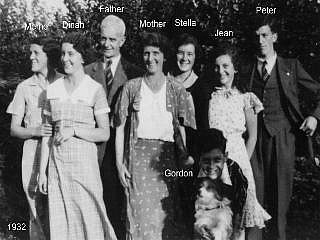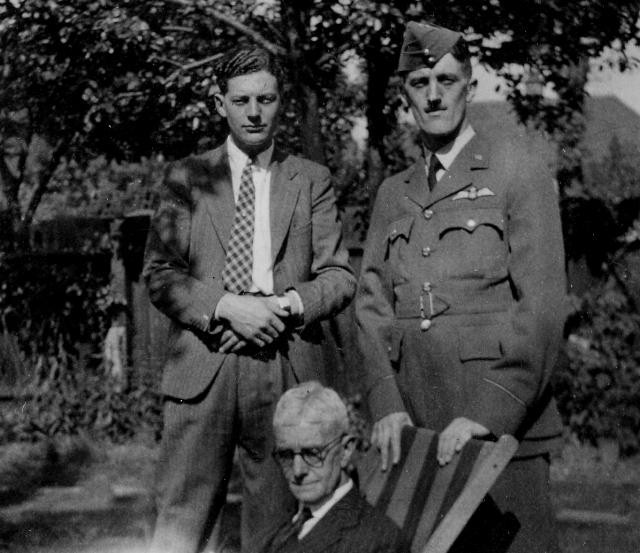My brother Peter Robinson was a Hurricane Pilot in 56 Squadron based at North Weald. He fought in and survived the Battle of Britain but was killed the following year, on the 17th June 1941. Peter is buried in St Andrews Churchyard, North Weald.
After training Peter joined 56 Squadron at North Weald on 25th July 1940. When he first tried to join the RAFVR he was not accepted as unfortunately he had a very bad stammer. In the 11 months before the war through many months of dedicated effort he had managed to cure his stammer through swapping everything from his right hand to his left hand. This he did meticulously down to the last detail. He was accepted by the RAFVR for training from the beginning of the war and obtained his wings by 1940. As Sgt. Robinson he flew a Hurricane all the way through the Battle of Britain.
Peter was born on 13th April 1913, the third in a family of six, the children of Mr & Mrs Herbert Robinson of Harrow. We all had a normal happy childhood despite the fact that Father had to spend long periods abroad, mainly South America, Australia and New Zealand, and this was in the days when sea travel was the only option (about 6 weeks to Australia). Our Father was the Chief Accountant of Weddel & Co of Smithfield, London and he was responsible for setting up all necessary office systems and procedures for cold storage and slaughter works in New Zealand.
Peter was educated at Harrow County Grammar School and obtained a matriculation certificate at the age of 16. He was a member of the army cadet force and as an athlete represented the school under 15's. He started work as a trainee in the wool business in the Midlands (Vestey Organization). He was a member of the Crusader Bible Class and was much interested in Mission work. On a bicycling holiday in 1937 through the Black Forest he returned fully believing Germany was preparing for war. Apart from one sister, Dinah who was in Canada, Meme and Stella, my two elder sisters’ husbands were both in cadet camp at the start of the war, so immediately went into their regiments. I was engaged and then married my husband Ken, who was an Air Gunner in Lancasters. On a raid he took a bullet wound through his shoulder and his plane was crippled but managed to make it to Ford airfield near Chichester. His two cousins, John and Tony, were both Pilots in the Air Force but did not survive the war, along with various other members of the family.

The Robinson family before the war
My friends at North Weald Airfield Museum have researched their records, including a recently presented copy of 56 Squadron logbook for 1939/1941, for references to Peter. On 16th August 1940 Sgt. Robinson and F/O Booker damaged two Dornier215s. On 16th August 1940 Sgt. Robinson shot down a Me110c over Ashford, Kent at 13.00 hours and at 13.40 hours shot down a second Me110c over Ashford. This one crashed at Pluckley.
An entry in 56 Squadron logbook for 5th June 1941 states "Sgt. Robinson granted commission as P/O".
Mother, Father, 3 sisters and Gordon were living at home when Peter was reported missing and when the news came that his body had been washed up 7 days later. He was shot down over the Channel on 17th June 1941 and was missing for some days. Peter had only collected his new uniform 48 hours before he died, and the family managed to take a photograph of him. He came home on the 15th June and my sister Stella had to sew all the nametapes into everything. He went back to North Weald on the 16th June. His other gear had to follow on. He was killed the next day 17th June (Stella’s birthday) so everything was returned unopened for my sister to remove all the nametapes and return the uniform to Simpson’s.
Peter in his new uniform with father and brother Gordon. The day after this photograph was taken Peter was killed in action.
The family coped like any other bereaved family - there was a Military Funeral at North Weald. Peter is remembered as a quiet loving member of our family. Over the years we have visited North Weald on many occasions and in the early days our Father obtained the home addresses of several overseas Pilots buried there and would write to tell the families we had visited. Also over the years various members of the family have attended the annual Battle of Britain service held in Westminster Abbey each September. On 3rd September 2000 with a number of my relatives, I attended the Dedication of the new North Weald Airfield Memorial. Peter’s name is one of those in the Debt of Honour available from the brass cabinet set in the wall.
The final reference to Peter in 56 Squadron’s logbook is dated 17th June 1941 and says: "Offensive patrol by the whole Squadron, which took part in a circus (RAF code word for a sweep) operation as close support to a force of bombers. F/Lt Higginson DFM, P/O Harris, P/O Robinson and Sgt Carvell missing after the operation, during which the Squadron was continuously attacked by Me109s but was unable to do more than stick by the bombers and defend them from attack. In this the Squadron was entirely successful".

On the 17th July 2003 Peter Robinson from Western Australia visited the Museum and the churchyard. He is the nephew of P/O Peter Robinson. He is also the son of Gordon, shown in the above photograph. Gordon, Peter's younger brother, was also a Hurricane pilot in 56 Squadron. He was later in City of Glasgow Squadron. Gordon's flying career came to an end when he crashed at Cottishall and broke his back. He emigrated to Perth in Australia after the war.
© J Porter Photograph 2003, E M Aitken
